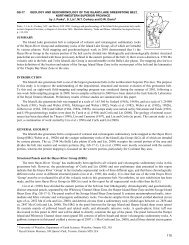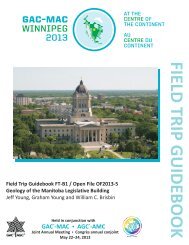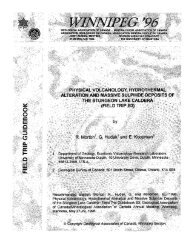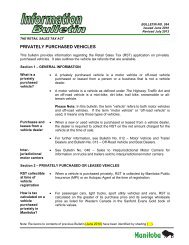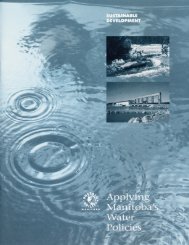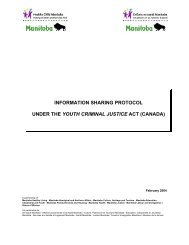Nutrient Management Strategy - Government of Manitoba
Nutrient Management Strategy - Government of Manitoba
Nutrient Management Strategy - Government of Manitoba
You also want an ePaper? Increase the reach of your titles
YUMPU automatically turns print PDFs into web optimized ePapers that Google loves.
Page 3Item 2 - Derive Numeric Objectives for <strong>Nutrient</strong>VariablesResults from preliminary work on some <strong>of</strong> theissues in Item 1 indicate that the current <strong>Manitoba</strong>Surface Water Quality Objectives and objectivesin place elsewhere in the prairies for nutrients areinadequate. Because <strong>of</strong> this, the derivation <strong>of</strong> newnumeric objectives for nutrient variables is one <strong>of</strong>the first challenges in the development <strong>of</strong> anutrient management strategy for southern<strong>Manitoba</strong>. Numeric objectives, as opposed tonarrative objectives, are important in controllingeutrophication because they allow water qualitymanagers to make informed, scientificallydefensible decisions with regard to regulatingnutrient inputs to surface waters.Two approaches to deriving numeric nutrientobjectives will be used simultaneously. These are:(1) Regional Based Objectives and (2) ObjectivesBased on Receiving Waters.(1) Regional Based ObjectivesThe chemical and physical characteristics <strong>of</strong> awaterway are determined in large part by thefeatures <strong>of</strong> its drainage basin or watershed.Topography, natural vegetation cover, land-usepractices, climate, geology, and soil type can varyconsiderably between watersheds, and as a result,no two waterways are exactly the same in terms <strong>of</strong>flow regime, physical characteristics, and waterchemistry. The growth <strong>of</strong> algae and macrophytesis dependent in large part on the availability <strong>of</strong>phosphorus and nitrogen. However, primaryproductivity in streams is also influenced by lightexposure, temperature, water clarity, flow regime,grazing, the presence <strong>of</strong> toxic pollutants, andmicro-nutrient concentrations, all <strong>of</strong> which varybetween waterways.Given the considerable variation that existsbetween aquatic systems, it is unrealistic that asingle numeric objective for each nutrient variablecould be applicable to all the rivers and streams insouthern <strong>Manitoba</strong>. It is apparent that more sitespecificobjectives are required. Although theestablishment <strong>of</strong> nutrient objectives for individualwaterways is impractical at this time, it isreasonable to consider deriving nutrient objectivesat a regional scale.Regional boundaries for regionally-basednutrient objectives can be based on ecologicalunits such as ecozones or ecoregions, or ondrainage units such as drainage basins orwatersheds. The scale at which the regionalboundaries are set is dependent on the level <strong>of</strong>environmental variability that is deemedacceptable, and the amount <strong>of</strong> the resources thatcan be devoted to the derivation process.Once regional boundaries are established theprocess <strong>of</strong> developing nutrient objectives for theregions can proceed. Major tasks to undertake inthe development <strong>of</strong> regional nutrient objectivesinclude:A. Identify the major problems associated witheutrophication within each region andprioritize which regions and waterwaysrequire the most immediate attention.B. Identify core variables used to assesseutrophication in southern <strong>Manitoba</strong> (these arethe variables for which objectives will beestablished).C. Develop focused monitoring programs orstudies, if required, to better define therelationship between nutrients and primaryproductivity and to identify any temporal orspatial trends in rivers within each region.D. Identify reference streams or reaches thatrepresent ambient <strong>of</strong> non-impacted conditionswithin each region.E. Analyze the data using acceptable statisticalmethods and empirical and simulation modelsto identify relationships between nutrientconcentrations and primary productivity.<strong>Nutrient</strong> objectives have to be scientificallydefensible; otherwise they will be <strong>of</strong> littlevalue when it comes to managing andregulating nutrient inputs to streams and riversfrom point and non-point sources.F. Derive nutrient objectives based on the results<strong>of</strong> the statistical analysis and modelling work.For Additional Information, Visit <strong>Manitoba</strong> Conservation’s Website for Current Issues - Latest Newswww.gov.mb.ca/environ/



